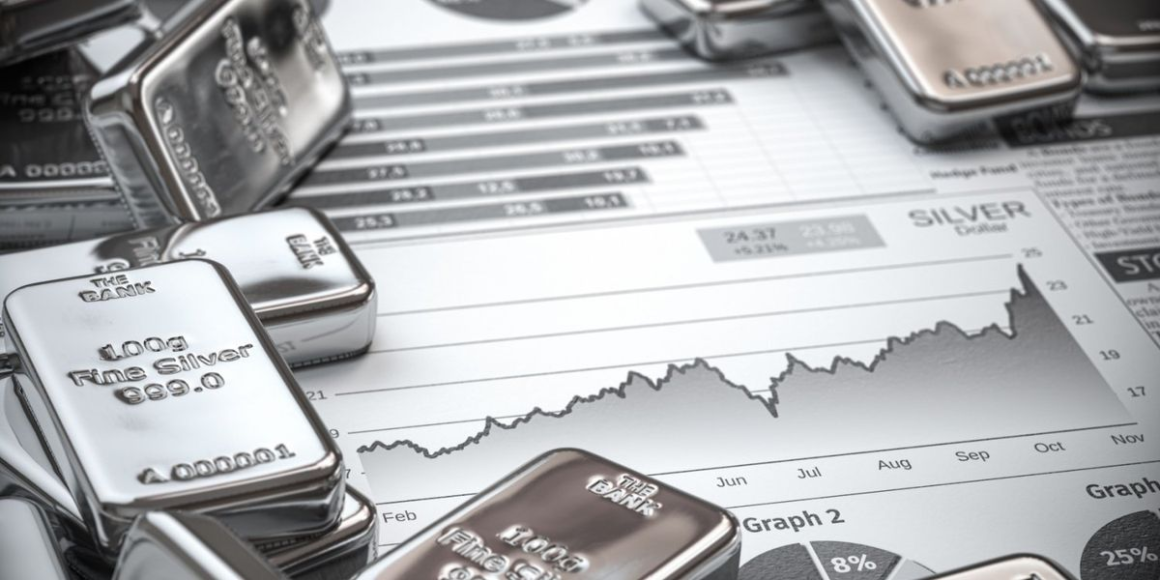Like its sister metal gold, silver has been attracting renewed attention as a safe-haven asset.
The answer reveals how much potential there is for the silver price to rise. Read on for a look at silver’s historical moves, and what they could mean for both the price of silver today and the white metal’s price in the future.
Before discovering what the highest silver price was, it’s worth looking at how the precious metal is traded. Knowing the mechanics can be useful in understanding why and how its price changes on a day-to-day basis and beyond.
Put simply, silver bullion is traded in dollars and cents per ounce, with market activity taking place worldwide at all hours, resulting in a live silver price. Key commodities markets like New York, London and Hong Kong are just a few locations where investors trade the metal. London is seen as the center of physical silver trade, while the COMEX division of the New York Mercantile Exchange, called the NYMEX, is where most paper trading is done.
There are two popular ways to invest in silver. The first is through purchasing silver bullion products such as bullion bars, bullion coins and silver rounds. Physical silver is sold on the spot market, meaning that in order to invest in silver this way, buyers pay a specific price for the metal — the silver price per ounce — and then have it delivered immediately.
The second is accomplished through paper trading, which is done via the silver futures market, with participants entering into futures contracts for the delivery of silver at an agreed-upon price and time. In such contracts, two positions can be taken: a long position to accept delivery of the metal or a short position to provide delivery.
Paper trading might sound like a strange way to get silver exposure, but it can provide investors with flexibility that they wouldn’t get from buying and selling bullion. The most obvious advantage is perhaps the fact that trading in the paper market means silver investors can benefit long term from holding silver without needing to store it. Furthermore, futures trading can offer more financial leverage in that it requires less capital than trading in the physical market.
Market participants can also invest in silver through exchange-traded funds (ETFs). Investing in a silver ETF is similar to trading a stock on an exchange, and there are several silver ETFs to choose from. Some ETFs focus on physical silver bullion, while others focus on silver futures contracts. Still others focus on the silver stocks or follow the live silver price.
The silver all-time high was US$48.70 per ounce, a level it reached on January 18, 1980.
Silver wouldn’t test that high again until 2011. At that time, its price uptick came on the back of very strong silver investment demand, and was more than double the 2009 average silver price of US$14.67.
The chart below from Trading Economics spans from the start of January 2010 to May 2024. It shows that silver reached US$47.94 in April 2011 before plummeting in the years that followed.
The chart also shows the upward trend in the silver price starting in mid-2020, when it was spurred on by the economic uncertainty surrounding the COVID-19 pandemic. The price of silver breached the key US$26 level in early August 2020, and soon after tested US$30; however, it failed to make substantial progress past that.
Market watchers are curious as to when the silver price will continue its upward trajectory. Only time will tell, and it will depend on the white metal’s ability to remain above the critical US$30 level.
In other words, it’s bought by investors who want it as a store of wealth, as well as by manufacturers looking to use it for different applications that are incredibly varied. For example, silver has diverse technological applications and is used in devices like batteries and catalysts, but it’s also used in medicine and in the automotive industry.
The firm is forecasting an 0.8 percent decline in global silver mine production to 823.5 million ounces in 2024. Analysts are anticipating a resumption of full production at Peñasquito post-strike action. In countries such as the US and Morocco, expansions and new projects are expected to contribute to supply growth. However, a significant drop in silver production out of Peru and China is expected to offset these increases.
Looking at demand, Metals Focus is projecting 2 percent growth for 2024 as industrial fabrication is expected to reach another all-time high on a projected 20 percent increase in demand from the solar market. This could be tempered by an anticipated contraction of 13 percent for physical investment in silver bars and coins.
The silver market is expected to experience a substantial deficit of 215.3 million ounces in 2024, amounting to the second highest discrepancy in over two decades.
As a final note on silver, it’s important for investors to be aware that manipulation of prices is a major issue in the space.
While silver has neared US$50 multiple times, including its all-time high, it’s anyone’s guess whether it will reach those heights once again. Even so, many commentators say prospects are bright for buying silver — and no matter the current state of the market, investors will no doubt be watching to see how the metal fares.
This is an updated version of an article first published by the Investing News Network in 2015.
Securities Disclosure: I, Melissa Pistilli, currently hold no direct investment interest in any company mentioned in this article.


Leave a Reply